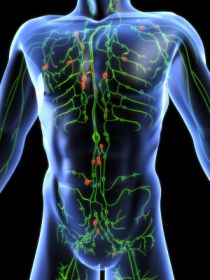Our Lymphatic System
BY: DR. MELINA ROBERTS
 The lymphatic system is our secondary circulatory system. It plays an important role in supporting our immune system and treating inflammation in the body. The lymphatic system circulates throughout the entire body. The lymphatic system is made up of lymphatic fluid, lymphatic vessels, lymphatic nodes, the spleen, the thymus, tonsils and Peyer’s patches in the gut. The lymphatic system drains and cleans up all the tissues in our body.
The lymphatic system is our secondary circulatory system. It plays an important role in supporting our immune system and treating inflammation in the body. The lymphatic system circulates throughout the entire body. The lymphatic system is made up of lymphatic fluid, lymphatic vessels, lymphatic nodes, the spleen, the thymus, tonsils and Peyer’s patches in the gut. The lymphatic system drains and cleans up all the tissues in our body.
Lymph nodes are biological filtering units and are distributed throughout the body. Lymph nodes produce white blood cells called lymphocytes that defend the body against microorganisms and other harmful pathogens or toxins in the lymphatic fluid before it returns to the blood stream.
The obvious sign that the lymphatic system is congested or not flowing effectively is edema or swelling, but there is often more subtle signs such as lowered immune function, chronic infection, chronic inflammation and reduced detoxification capacity. Reduced immune reactivity is another sign of lymphatic congestion. The immune system can become less reactive to microorganisms or toxins if the body is in acidosis, therefore when a person says that they never get sick, it is not necessarily a good sign.
Promoting lymphatic drainage is significant in addressing inflammation. The lymphatic system removes and filters inflammatory mediators.
The lymphatic system can become congested from food intolerances, immune challenges, heavy metals, environmental toxins, surgery, scars or structural imbalances.
Food intolerances can lead to the ineffective breakdown of foods where certain proteins get caught in the lymphatic fluid. Immune challenges such as viruses, bacteria, fungi or parasites whereby the lymphatic system is working to removing and eliminate these pathogens from circulation can lead to congestion of the lymphatic system. Heavy metals and environmental toxins will congest the lymphatic system as they overload the detoxification pathways and this leads to chronic inflammation. Scars or surgery or structural imbalances can lead to physical barriers in effective drainage of the lymphatic system.
When trying to improve lymphatic circulation, it important to also understand flow pathways of this closed internal system. We have a superficial lymphatic system that drains our head, neck, skin and breast tissue. Then we have a deep lymphatic system that drains all of our deep vital organs. The superficial lymphatic system drains into the deep lymphatic system, the fluid then filters through the liver and empties out the colon.
Most typical lymphatic massages only focus on the superficial lymphatic system and without properly stimulating the deep lymphatic system, there cannot be proper drainage of the superficial lymphatic system into the deep lymphatic system. Also if the liver is congested or the colon is not moving effectively, then can back up the system and cause congestion of the lymphatic system.
In order to support proper lymphatic drainage, the deep lymphatic system needs to be stimulated, the liver to be supported and the bowels need to be moving effectively.
